The First Major Law of the Universe—All is One
The Kabbalistic Tree of Life expresses four major laws which govern the Universe, the first being—All is One. This means that everything is interconnected and nothing occurs in isolation. Whatever happens anywhere affects the whole, and vice versa. Everything we see (not to mention the things we cannot see) is One thing.
If this seems counterintuitive to you, you are not alone. I tend to be a very rational, left-brained thinker and was skeptical about the Law of One when I first learned of it. I thought it was a nice sentiment but not necessarily a factual one.
However, one of my first awakening experiences revolved around realizing the truth in the Law of One. I could see how one thing can be all things as I reflected on Einstein’s famous equation, E=mc², from his special theory of relativity. This scientific equation illustrates how matter and energy are two forms of the same thing. Everything is energy—energy that takes many different forms and is constantly shifting and changing.
The Kabbalistic Tree is a brilliant tool for deepening one’s understanding of this first major universal law. The symbol of the Tree shows visually how All can indeed be One—One thing that is divided into different attributes.
The 10 Sefirot
(Note: Sefirot is plural; sefirah is singular.)
As the One thing moves down through the Tree, 10 qualities of the One are expressed. Beginning with Keter, the Divine Unmanifest, at the top, the emanation of qualities is said to flow down through the Tree like a flash of lightning until Malkuth, the Divine Manifest, is reached at the bottom.
These emanations are known as the 10 sefirot and are represented by the white circles on the Tree above. They are said to appear out of Nothing and to be without beginning or end. Each is an attribute or power of the Divine One, and together they reflect the entire process of creation and the relationship between the spiritual and material realms.
Beginning at the top and following the lightning flash down through the Tree, you will find the sefirot as follows:
- Keter (Crown) – Represents the first creative impulse, the basic will to be inherent in consciousness.
- Chokhmah (Wisdom) – Represents the first expression of the impulse to be—the arising of thought within the field of awareness.
- Binah (Understanding) – Represents the development of thought, the actual activity of thinking.
- Chesed (Loving-Kindness) – Represents unconditional love. It can be understood as the force or energy that flows outward, pouring forth kindness and affection toward others.
- Gevurah (Judgement) – Represents the reigning in of the outward expansion of Chesed.
- Tiferet (Beauty) – Represents the essence of the thing created. It is considered the central, unifying sefirah in the Tree of Life.
- Netzach (Victory) – Represents endurance, persistence, and the determination to persevere.
- Hod (Glory) – Represents humility, acknowledgment, and surrender to the divine will.
- Yesod (Foundation) – Represents the foundation that connects the higher sefirot to the physical world.
- Malkuth (Kingdom) – Represents the manifestation of the Divine in the physical world. It is the vessel that receives the energy from all the other sefirot.
(Note: The descriptions of the sefirot above are gathered from various sources, including two of my favorite books on Kabbalah—Kabbalah for Beginners and Adam and the Kabbalistic Trees—as well as ChatGPT.)
The Unmanifest Sefirah: Da’at
There is an additional location on the Tree which separates the upper triad of Keter, Chokhmah, and Binah from the lower sefirot. It is the hidden, unmanifest sefirah of Da’at, represented by the black circle near the top of the Tree. It is sometimes known as the Abyss.
Da’at is the Hebrew word for Knowledge. In the modern world, we often think of knowledge as being intellectual. However, Da’at is more than pure intellectual comprehension. It is knowledge embodied through lived and felt experience.
Conclusion
If the various concepts of Kabbalah seem foreign and confusing to you at first, I hope you won’t be discouraged. I have found that one of the most valuable aspects of exploring the Tree of Life is that it’s impossible to automatically pigeonhole its concepts in my mind.
Through the years, I’ve learned to tread lightly when reflecting on the One Thing and its attributes. Many times, after reasoning through a sefirah’s qualities for an extended period, I come to realize that I may have it completely backwards.
This is powerful. In this uncanny way, the Tree helps me recognize and reconcile paradox. It often leads me into the more expansive realm of the right brain, where I find myself embracing nuance and possibility—qualities that have allowed me to open more to the beauty of mystery.

